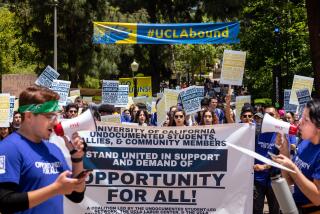Students Press L.A. Supervisors to Join Fight Against Child Labor
Monroe High School senior Joseph Jung winces at the image: children trapped in dark hovels, stitching soccer balls 12 hours a day.
The childrenâs sweatshops may be in foreign lands, but Jung and a group of Monroe classmates are waging their own fight to end a practice that human rights groups say condemns millions of children to lives of misery.
Today, the Los Angeles County Board of Supervisors will consider a motion inspired by the Monroe students that will require companies selling balls to the county to certify that the manufacturers used no child labor.
The studentsâ crusade is part of an ongoing effort by Monroeâs law and government magnet program to end a practice that they say robs peers of their youth by working in dangerous conditions with few if any safeguards.
Last year, another Monroe class persuaded the Los Angeles Board of Education and the Los Angeles City Council to bar the purchase of balls from manufacturers known to use child labor.
âWe are horrified by the human rights abuses of young children within countries like China, Pakistan, Indonesia and others,â said Jung, 17, who with his classmates has spent the fall semester studying child labor. âChildren as young as 6 years old are taken from their homes and put into factories to stitch soccer balls while making a meager 60 cents a day. If I was in that situation, I would want someone to help me.â
The Monroe studentsâ efforts also are part of an international movement to stop the use of child labor, which affects an estimated 250 million children worldwide, according to Darlene Adkins, coordinator of the Washington D.C.-based Child Labor Coalition, whose 50 organizations battle the problem.
Adkins and other experts said that Pakistan produces about 90% of the soccer balls imported to the United States. Balls also are manufactured in China, Indonesia and other countries, she said.
The issue has inspired several attempts to reform a multimillion-dollar business in which children earn about 60 cents per ball, completing one or two a day while working in dark conditions with sharp tools and little oversight, human rights experts say.
Among the most visible critics is Craig Kielburger, a Canadian teenager whose international youth movement, Free the Children, has cast a spotlight on child labor, from his countryâs parliament to the U.S. Congress.
Kielburger launched his crusade after learning the story of Iqbal Masih, a Pakistani boy who was sold into bondage as a carpet weaver at age 4. At age 10 he escaped and became an outspoken critic of child exploitation until he was murdered in 1995.
Throughout the United States, schools have launched their own efforts, writing members of Congress and raising money for child labor groups. A Quincy, Mass., school raised more than $100,000 to build a school in Masihâs honor in his village.
At Monroe, international law teacher Mark Elinson offered a two-week fall 1996 course about child exploitation after he saw a television program about Kielburger and Masih. The class has evolved into a semester-long course.
Thirty of Elinsonâs students are studying the issue, hoping to capitalize on the gains made by last yearâs class. They have gathered information from the Internet and by reading news accounts and reports from human rights groups.
Last month, they sent the five supervisors a packet of material about child labor and soccer balls, urging action.
With the assistance of the students, Supervisor Zev Yaroslavskyâs chief deputy, Alisa Katz, wrote the motion on todayâs agenda.
âThey were totally instrumental. They brought it to our attention,â Katz said. âTheir material was very well researched. They were impressive.â
The motion requires companies to verify that none of the balls they sell to the county has been manufactured with child labor. In addition, the measure requires companies to verify which countries their soccer balls come from. For those balls manufactured in Pakistan, the seller must certify annually that the supplier has signed a recent international agreement that seeks to eliminate child labor in that country.
The county buys about 800 soccer balls each year, spending between $5,000 and $7,000 for the equipment that is used at county parks, juvenile halls and in other programs.
Katz said that balls come from two vendors, and most are produced in China. She said the county does not believe that child labor is used in their manufacture.
Several of the Monroe students who will address the supervisors today said they believe the supervisors should enact the measure to make a statement. The teenagers, who are part of the magnetâs activist effort Students Against Kid Exploitation, said they were speaking out to educate teenagers and adults alike.
âIf we make the presentation and they donât take action, then it shows they have no morals,â said senior Adam Pitcher, 17. âItâs important for them to know, because they may be indirectly supporting child labor.â
The students said they also hoped that the supervisors would go a step further than the Los Angeles Unified School District, whose motion last year allows companies to certify on their own that they use no child labor--an arrangement the students believe undercuts the measure. L.A. Unified officials said they lack the personnel to investigate.
Even as one group of Monroe students makes its pitch at the Hall of Administration, another will be meeting this morning with Rep. Howard L. Berman (D-Mission Hills) to ask what he has done to address child exploitation on the federal level. Other groups from the international law class have contacted corporations and arranged for an official from the Mexican consulate to speak to the class about child labor.
The students plan to turn their attention next to other teenagers: They are seeking speaking engagements at several San Fernando Valley high schools.
âItâs a good grass-roots campaign against child labor,â senior Gazelle Javantash said of the overall effort. âIf the United States was able to get rid of child labor, then other countries should too.â
More to Read
Sign up for Essential California
The most important California stories and recommendations in your inbox every morning.
You may occasionally receive promotional content from the Los Angeles Times.










